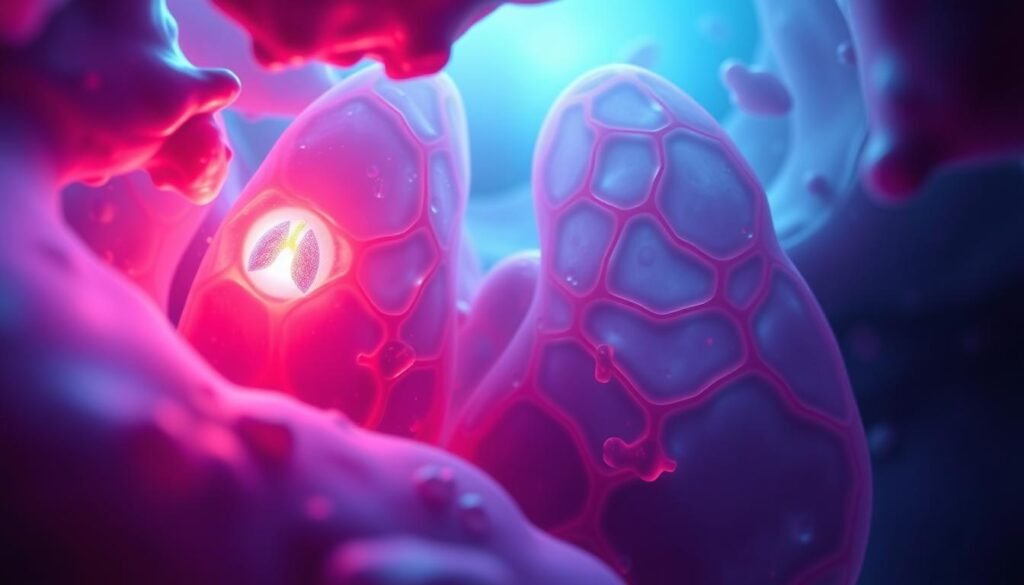Did you know small cell lung cancer (SCLC) makes up only 15-17% of all lung cancer cases? It’s one of the most aggressive forms, greatly affecting survival rates. For 231 patients with limited-stage disease and 308 with extensive-stage disease, prognosis after chemotherapy is very different. We aim to share key survival rates and treatment outcomes. This could help patients and their families on this tough path.
Key Takeaways
- SCLC represents a small yet aggressive portion of lung cancer cases.
- Survival rates are notably different between patients with limited and extensive-stage SCLC.
- A significant percentage of patients benefit from combined chemotherapy and radiotherapy.
- Smoking cessation can notably improve prognosis after diagnosis.
- Clinical trials continue to play a vital role in advancing treatment options.
Understanding Small Cell Lung Cancer
Small cell lung cancer (SCLC) makes up about 15 percent of all lung cancers. It is mainly linked to heavy tobacco use. Most people with SCLC are older, usually around 65. It’s important to know about SCLC to manage and treat it well.
There are two main types of SCLC: limited-stage and extensive-stage. Limited-stage means the cancer is only in one lung and maybe close lymph nodes. Extensive-stage SCLC has spread more widely. Knowing which type helps doctors decide on treatment.
SCLC grows fast, leading to symptoms like coughing, breathing problems, chest pain, and losing weight. These signs often appear late, making early detection key. Those with limited-stage SCLC usually get both chemotherapy and radiation therapy. This helps attack the tumor and nearby lymph nodes.
For SCLC, systemic therapy often means chemotherapy, sometimes with immunotherapy drugs like atezolizumab or durvalumab for extensive cases. Chemo is usually given every three weeks. However, side effects like tiredness, nausea, and losing hair can affect treatment.
It’s crucial to understand the link between smoking and SCLC. Smoking is the biggest risk factor. Yet, environmental toxins and genetics may also contribute. Knowing these risks can help in preventing SCLC and creating better treatments.
Stages of Small Cell Lung Cancer
Small cell lung cancer (SCLC) has two main stages: limited stage SCLC and extensive stage SCLC. These stages show how much the cancer has grown. This information helps decide on the best treatment and predicts how patients might do.
Limited stage SCLC is found in about 33% of people with this cancer. It stays on one side of the chest. Early treatment significantly helps, giving a 5-year survival rate of around 27%. This shows why finding the cancer early is vital.
Extensive stage SCLC is seen in about 66% of patients when they’re first diagnosed. The cancer has spread beyond the chest at this point. Sadly, these patients have a tougher time, living only about 8 to 13 months on average after diagnosis. While 60% to 80% respond to chemotherapy, only 15% to 20% achieve complete remission.
SCLC is very aggressive. About 70% of patients are diagnosed at the extensive stage. This highlights the urgent need to raise awareness and encourage early screening, especially in those at high risk.
Prognosis After Chemotherapy for Small Cell Lung Cancer
The outlook for patients with small cell lung cancer (SCLC) after chemotherapy differs a lot. It mainly depends on how early the cancer is found and how it responds to treatment. It’s important for patients, their families, and medical teams to understand these differences as they deal with this tough disease.
Overview of Survival Rates
Survival rates for SCLC show the tough battle with this disease. A study of 988 patients found a median survival time of 16.0 months. Those with limited-stage SCLC had a better chance, living for a median of 24.0 months. However, those with extensive-stage SCLC had a median survival of just 11.0 months.
The five-year survival rates are low, with only 5% to 10% of patients making it past five years after their diagnosis. For those with limited-stage SCLC, about 14% may live five years, showing the big difference stages can make.
Factors Influencing Prognosis
Different factors can affect a patient’s outlook after chemotherapy for SCLC. Some of the key factors include:
- Performance Status: Patients in good health otherwise (ECOG 0–1) usually do better.
- Response to Initial Treatment: How well patients respond to their first treatment matters a lot.
- Metastatic Sites: Being free of cancer spread to places like the liver or bones is better.
- Radiotherapy: Adding brain (prophylactic cranial) and chest (local thoracic) radiation helps.
- Additional Systemic Treatments: Getting more types of chemotherapy can lead to better survival.
By the end of the study, 60.3% of participants had passed away, which highlights the critical need for more research and better treatments for SCLC.
Limited vs. Extensive Stage SCLC
The difference between limited stage SCLC and extensive stage SCLC is key in defining treatment and predicting outcomes. Around one third of those diagnosed with small cell lung cancer (SCLC) have limited stage SCLC. In this stage, the cancer is only on one side of the chest and may affect one lung and some lymph nodes nearby.
Patients with limited stage SCLC often undergo aggressive treatments. This usually includes both chemotherapy and radiotherapy. Such treatments can cure about 20–25% of these patients. With the right treatment, these patients usually live longer and feel better.

However, about two thirds of people find out they have extensive stage SCLC. This means the cancer has spread to more places, like both lungs, distant lymph nodes, or other organs. The AJCC TNM staging system calls this stage 4. This stage is harder to treat and is not considered curable. Yet, treatments like chemotherapy can improve life quality and lengthen survival time. But, the outcomes are not as good as with limited stage SCLC.
Knowing the differences between limited and extensive stage SCLC helps doctors create the best treatment plans. They consider the stage of cancer and the patient’s health before deciding what to do.
First-Line Treatment Options
Small cell lung cancer (SCLC) needs careful management, especially with first-line treatments. The main path involves various chemotherapy plans. These are built to fight the cancer’s tough nature. They also set the stage for other treatments.
Chemotherapy Regimens
In those with limited-stage SCLC, combining cisplatin and etoposide is a top choice. This mix has shown to work well in most cases. Along with this, many get thoracic radiotherapy to make the treatment work better.
When it comes to extensive-stage SCLC, chemotherapy is key. It often includes cisplatin and other drugs aimed at the best results. One study found that this mix led to longer survival than other treatments.
The Role of Radiotherapy
Radiotherapy plays a big role in fighting SCLC. It works best with chemotherapy, especially in early stages. Studies show people getting both treatments live longer than with just chemotherapy. This combo offers a strong way to tackle this disease.
For more detailed info on treatment results, check out this in-depth analysis here.
Second-Line Treatments and Their Impact
Understanding second-line treatments for small-cell lung cancer (SCLC) is vital. It matters a lot for patients who don’t do well with the first treatments. Picking the right patients for second-line therapy changes how well these treatments work and can affect how long patients live. Not every patient will benefit from these treatments, so choosing the right ones is key.
Importance of Patient Selection
Choosing patients for second-line treatments depends a lot on how they responded to the first therapy. Doctors look at whether patients are “resistant,” “sensitive,” or “refractory” to guide their treatment. Those who responded well the first time are “sensitive” and usually do better with more treatment. On the flip side, “resistant” patients may not do as well.
Effectiveness of Second-Line Therapies
How well second-line therapies work can really vary among SCLC patients. Less than a quarter of patients see a good response. The time patients live after these treatments can be between 3.2 and 8.7 months. Noteworthy second-line options include topotecan, which can help patients live longer than supportive care alone. Also, immunotherapy together with chemotherapy, like atezolizumab, can help some patients live longer and slow down cancer.
| Treatment | Objective Response Rate (ORR) | Median Overall Survival (OS) |
|---|---|---|
| Topotecan | 15% | 4.6 months |
| CAV Regimen | 13-28% | 4.4 months |
| Pembrolizumab + Paclitaxel | 23.1% | 9.2 months |
| Amrubicin | 44% | Not reported |
| Lurbinectedin | Pending | Pending |
As new trials unfold, the options for second-line therapies are growing. This evolution in treatment aims to make these therapies more effective. The goal is to better help patients with small-cell lung cancer.
Clinical Trials and Future Perspectives
Clinical trials are key in finding new treatments for small cell lung cancer. These studies aim to boost survival rates. They tackle the challenges patients face head-on. Current research shows trials exploring chemotherapy and targeted therapies greatly improve outcomes.
The use of immunotherapy is promising. Studies on anti-PD-(L)1 and anti-CTLA-4 drugs show big improvements. These advances help with response rates and improving lives.
Trials like CASPIAN and IMpower133 show great results with immunotherapy and chemotherapy together. They offer better survival rates than seen before. This opens doors for new treatments that could change how we treat small cell lung cancer.
| Trial Name | Combination Treatment | Overall Survival (OS) | Progression-Free Survival (PFS) |
|---|---|---|---|
| CASPIAN | Durvalumab + Chemotherapy | 12.9 months | 5.1 months |
| IMpower133 | Atezolizumab + Chemotherapy | 12.3 months | 5.2 months |
Clinical trials give patients access to the latest therapies. They also help us learn more about small cell lung cancer. As research moves forward, the chance for better treatments grows. This could mean a higher quality of life for patients.
Managing Chemotherapy Side Effects
People treated for small cell lung cancer face challenges, especially from side effects. These effects can impact their life and their ability to stick with treatment. It’s vital to understand and manage these side effects to keep patients feeling well and committed to their treatment.
Common Side Effects
The most common side effects include:
- Nausea and vomiting
- Fatigue
- Hair loss
- Low blood cell counts, leading to increased risk of infections
- Loss of appetite
- Diarrhea
- Neuropathy, characterized by weakness and balance issues
Side effects like nausea and fatigue usually start soon after treatment begins. Managing these side effects well can help lessen them.
Strategies for Quality of Life Improvement
To manage side effects well, different strategies are important. These strategies may include:
- Adjusting chemotherapy doses to lessen symptoms
- Prescribing anti-nausea meds to help with vomiting
- Making dietary changes to improve nutrition and deal with appetite loss
- Starting physical therapy or rehab for neuropathy
- Getting psychological support and counseling for emotional stress
By teaming up with their healthcare providers, patients can find personalized solutions. These solutions help maintain their quality of life during treatment. For more details on managing side effects, including specific medicine combos and treatment plans, visit this resource.

The Role of Prophylactic Cranial Irradiation
Prophylactic cranial irradiation (PCI) is a key tactic in treating small cell lung cancer (SCLC). It’s for those who fully recover after chemotherapy. This method aims to cut down the risk of brain metastases. This issue is common in SCLC patients. About 15% have brain metastases without symptoms at diagnosis. This goes up to 25% with MRI scans.
Over 80% of SCLC patients get brain metastases within two years. Thus, having an effective plan is critical.
Since the late 1990s, PCI has been a part of treating limited-stage SCLC. It’s greatly reduced brain metastases – from 58.6% to 33.3% in three years. Also, patients with PCI saw a 5.4% drop in death rates. This shows PCI as crucial in care.
Yet, PCI has its risks. Symptomatic brain metastases fall to 16.8% in the PCI group. This is against 41.3% in those just watched. The long-term side effects of PCI need more study. Even so, its benefits for those in complete remission seem to outweigh the risks. More research is needed on PCI’s long-term effects.
Here is a brief of the main points about PCI in SCLC treatment:
| Key Findings | Implications |
|---|---|
| Improvement in median overall survival with PCI | Enhanced treatment outcomes for SCLC patients |
| Reduced incidence of brain metastases from 58.6% to 33.3% | Lower risk of symptomatic brain complications |
| 5.4% absolute reduction in mortality rates | Increased longevity for eligible patients |
| High incidence of brain metastases within 2 years | Urgent need for effective preventive treatments |
For more details, a systematic review of randomized trials provides deeper insights. It shows the important role of PCI in the SCLC treatment plan, especially for those fully recovered after chemotherapy.
Introduction to Palliative Care
Palliative care is crucial for lung cancer patients, especially in advanced stages. It focuses on managing symptoms to improve life quality. The care covers physical, psychological, social, and spiritual needs.
It can start at any disease stage, offering flexibility. Palliative care helps ease suffering and supports informed treatment choices. Studies show it can even extend life.
It addresses symptoms like pain and mental distress. Comfort care is key for these issues. Early palliative care can reduce harsh treatments at life’s end, improving satisfaction. The National Comprehensive Cancer Network guidelines recommend early start for better life quality.

Conclusion
Treating small cell lung cancer (SCLC) with chemotherapy is tricky. The results depend on how early the cancer is found and how well the patient reacts to the treatment. About 13% to 15% of all lung cancer cases worldwide are SCLC. Unfortunately, more than 90% of these patients don’t survive past five years. Yet, new treatments have started to help some patients live longer, especially those with cancer that hasn’t spread much.
If the cancer hasn’t spread far, the outlook is better. Patients might live 15 to 20 months on average. Some could even live five years or more. But, most people find out they have cancer only after it has spread. At that point, the chances of surviving decrease a lot. Studies show adding radiotherapy to chemotherapy could improve survival and control the cancer better. Knowing how to treat SCLC, including extra care and new treatments, is key to helping patients do better.
After getting chemotherapy for small cell lung cancer, continuing research and catching the cancer early are key. Experts emphasize the need for awareness and education. This helps people get the treatment they need faster. For more information on how medical coding affects patient care, check out this guide on ICD-10 codes for small cell lung. In the end, improving how long patients live and their quality of life will take more research and a full-care approach.